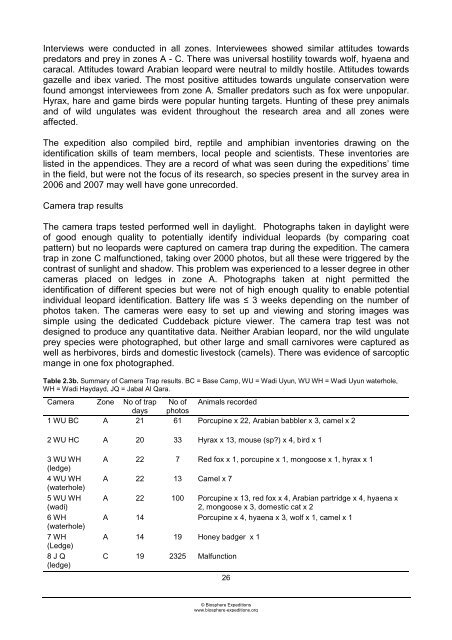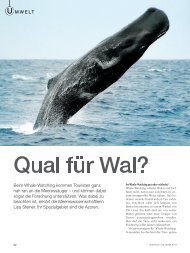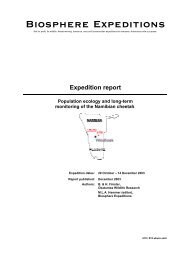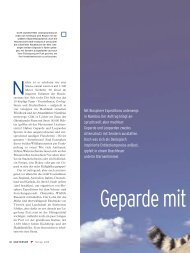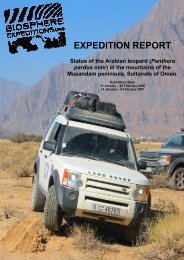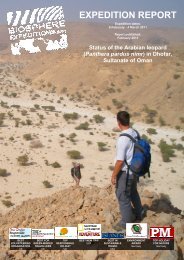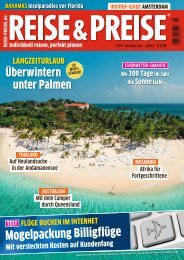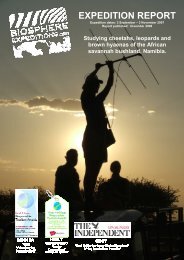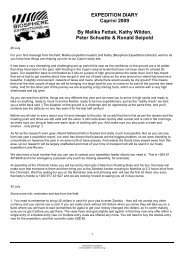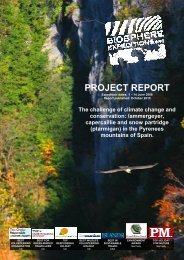EXPEDITION REPORT - Biosphere Expeditions
EXPEDITION REPORT - Biosphere Expeditions
EXPEDITION REPORT - Biosphere Expeditions
Create successful ePaper yourself
Turn your PDF publications into a flip-book with our unique Google optimized e-Paper software.
Interviews were conducted in all zones. Interviewees showed similar attitudes towards<br />
predators and prey in zones A - C. There was universal hostility towards wolf, hyaena and<br />
caracal. Attitudes toward Arabian leopard were neutral to mildly hostile. Attitudes towards<br />
gazelle and ibex varied. The most positive attitudes towards ungulate conservation were<br />
found amongst interviewees from zone A. Smaller predators such as fox were unpopular.<br />
Hyrax, hare and game birds were popular hunting targets. Hunting of these prey animals<br />
and of wild ungulates was evident throughout the research area and all zones were<br />
affected.<br />
The expedition also compiled bird, reptile and amphibian inventories drawing on the<br />
identification skills of team members, local people and scientists. These inventories are<br />
listed in the appendices. They are a record of what was seen during the expeditions’ time<br />
in the field, but were not the focus of its research, so species present in the survey area in<br />
2006 and 2007 may well have gone unrecorded.<br />
Camera trap results<br />
The camera traps tested performed well in daylight. Photographs taken in daylight were<br />
of good enough quality to potentially identify individual leopards (by comparing coat<br />
pattern) but no leopards were captured on camera trap during the expedition. The camera<br />
trap in zone C malfunctioned, taking over 2000 photos, but all these were triggered by the<br />
contrast of sunlight and shadow. This problem was experienced to a lesser degree in other<br />
cameras placed on ledges in zone A. Photographs taken at night permitted the<br />
identification of different species but were not of high enough quality to enable potential<br />
individual leopard identification. Battery life was ≤ 3 weeks depending on the number of<br />
photos taken. The cameras were easy to set up and viewing and storing images was<br />
simple using the dedicated Cuddeback picture viewer. The camera trap test was not<br />
designed to produce any quantitative data. Neither Arabian leopard, nor the wild ungulate<br />
prey species were photographed, but other large and small carnivores were captured as<br />
well as herbivores, birds and domestic livestock (camels). There was evidence of sarcoptic<br />
mange in one fox photographed.<br />
Table 2.3b. Summary of Camera Trap results. BC = Base Camp, WU = Wadi Uyun, WU WH = Wadi Uyun waterhole,<br />
WH = Wadi Haydayd, JQ = Jabal Al Qara.<br />
Camera Zone No of trap No of Animals recorded<br />
days photos<br />
1 WU BC A 21 61 Porcupine x 22, Arabian babbler x 3, camel x 2<br />
2 WU HC A 20 33 Hyrax x 13, mouse (sp?) x 4, bird x 1<br />
3 WU WH<br />
(ledge)<br />
4 WU WH<br />
(waterhole)<br />
5 WU WH<br />
(wadi)<br />
6 WH<br />
(waterhole)<br />
7 WH<br />
(Ledge)<br />
8 J Q<br />
(ledge)<br />
A 22 7 Red fox x 1, porcupine x 1, mongoose x 1, hyrax x 1<br />
A 22 13 Camel x 7<br />
A 22 100 Porcupine x 13, red fox x 4, Arabian partridge x 4, hyaena x<br />
2, mongoose x 3, domestic cat x 2<br />
A 14 Porcupine x 4, hyaena x 3, wolf x 1, camel x 1<br />
A 14 19 Honey badger x 1<br />
C 19 2325 Malfunction<br />
26<br />
© <strong>Biosphere</strong> <strong>Expeditions</strong><br />
www.biosphere-expeditions.org


